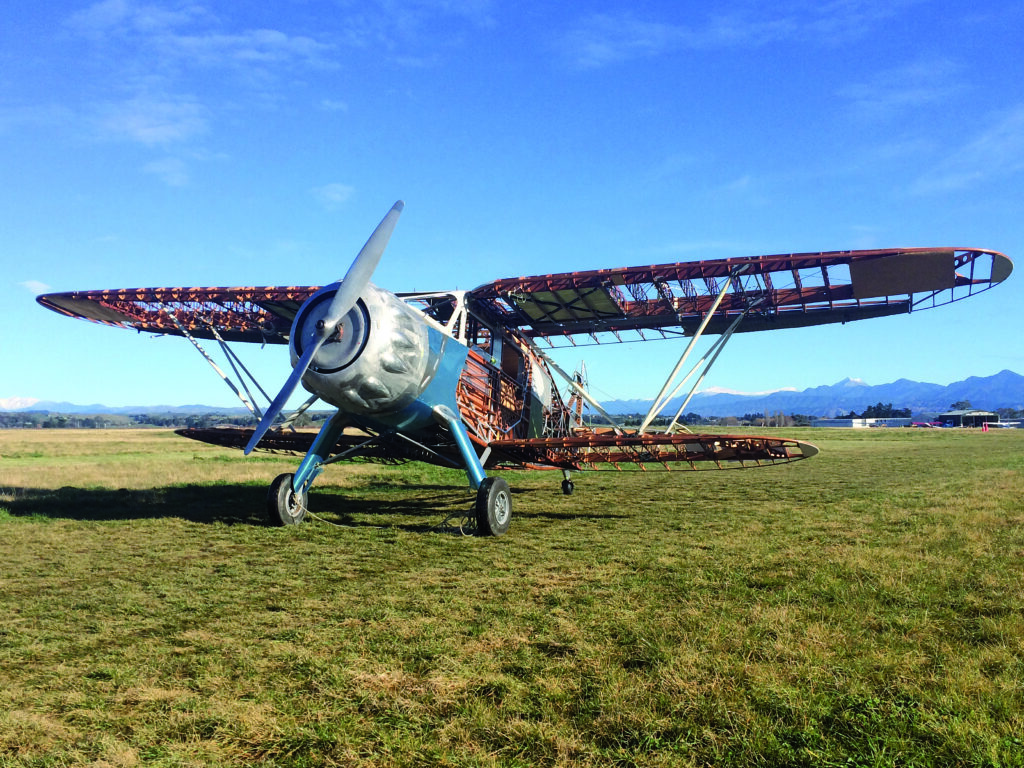By Jay McIntyre
I was going to pen another article of doom, gloom, disaster and financial ruin, but instead decided to write something uplifting in nature – which may or may not include one of the aforementioned descriptors… I’ll let you decide which one is apt!
Soon to take to the air for the first time since 1958, WACO UOC ZK-AEL is one of the coolest 1930s biplanes ever to see service in New Zealand (in my humble opinion anyway!). It has been a fourteen year project to return this magnificent machine to airworthiness, and as usual there is quite the story behind it.
WACO built our UOC as S/N 4336 in late 1935, when she was ordered by the Marlborough Aero Club to complement the older generation, British-designed aeroplanes in the Club’s fleet. She wasdelivered for assembly to de Havilland in Wellington in early 1936, and was on line in Blenheim by May of that year. Kitted out to be able to provide an ambulance stretcher service, she was soon plying her way and proving very popular.
Impressed into RNZAF service with the Communications Flight in 1939 as NZ575, she was said to be the pilots’ most popular mount, and later in the war became New Zealand’s first radar-equipped aeroplane, with a Pye TV mount in the back for radar trials!
Returned to Marlborough in 1946 as ZK-ALA, she returned to her original duties until a landing accident in 1948 saw her written off. I was fortunate to spend many hours talking to now deceased Club members, John Wright and Henry Gluyas, who were there the day the righthand main landing gear collapsed.
Purchased by Blackmores Flying Service, ZK-ALA was relocated to Rotorua and served in a very popular scenic flight business. Ultimately this business was bought out by James Aviation, but it’s unclear whether they continued the scenic flights or just used her as a company hack.

In 1958, whilst on conversion training, she was flipped on her back at Rotorua and written off. Bought by the Giltrap family, she became part of their motor museum and was ultimately moved to Coolangatta in Queensland with the rest of the collection. There, plans were made to return her to airworthiness but, as the type did not have a Type Certificate in Australia, this proved not to be legally possible at the time.
Moved up and down the eastern seaboard over the next twenty years, ALA finally came to rest in Sydney, where, with the rules having relaxed somewhat, restoration was eventually started.
The wings were rebuilt, the woodwork on the fuselage repaired and fabric applied to the fuselage, however by about 1985 work had ceased and the aircraft went to hiding for another twenty years.
For some reason, I had always been fascinated by the WACO cabins, though I’d never seen one in the flesh. Perhaps it was the wind-down windows, or that my Aero Club had bought her brand new. Graham Orphan planted a seed that would not stop growing and, while in Australia with the RNZAF, I searched off and on for ALA/AEL, but no one seemed to know her location or status. Eventually, in 2005, I sent a letter to the last-known owner asking if he would be keen to sell.
Nothing came of it and I moved on, starting my own business and getting engaged. One Sunday night the fax started going at midnight and, low and behold, the WACO was for sale. Darn it: what to do? I went to the Marlborough Aero Club bar one Sunday night, and a couple of weeks later I’d rustled up two partners. A trip to Australia to look at her (waste of time really, as the decision was already made – you know how it goes!) and then back a few months later to pack her up.

ZK-AEL returned to Marlborough fifty years after being written off.
I had great ideas about working on her while my employees carried out the business of JEM Aviation… how naive! Some sporadic work was carried out over the next few years, but it was not until around 2016 that one of my partners, Rex Newman, observed that if we did not get cracking, he’d be too old to fly her. Thus it was that a concerted effort was launched, with Rex pretty much working full-time on her over the last four years to bring her back to her former glory.
Perhaps, after another tale of woe and despair, I’ll write about the actual restoration…
This article first appeared in the Summer 2022 edition of Approach Magazine, the dedicated magazine of AOPA NZ, which is published quarterly.

